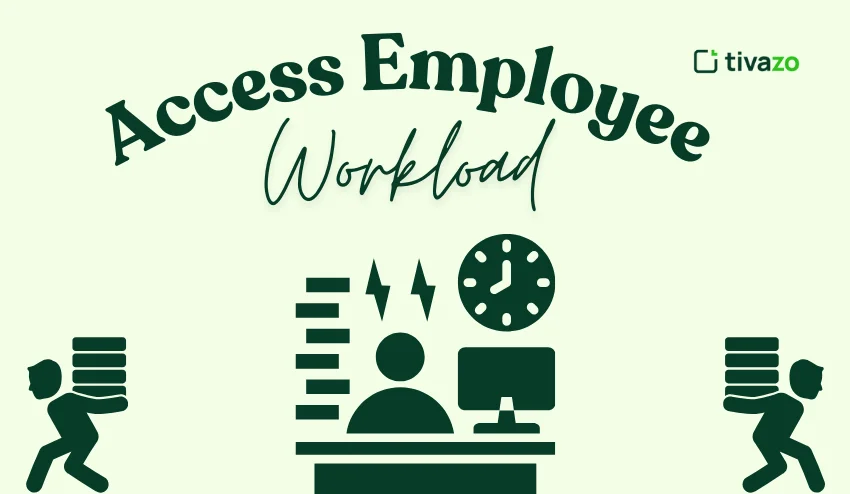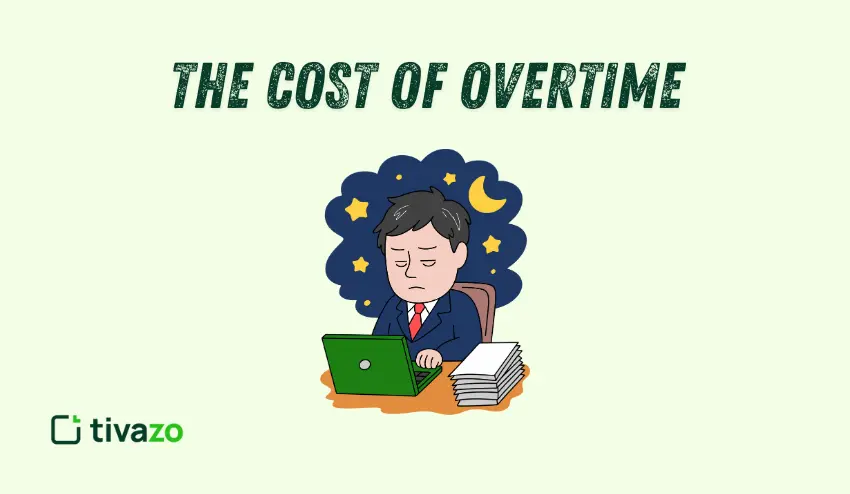Proper evaluation and management to access workload of employee workload is vital for productivity, fairness, and employee well-being. In 2025, organizations must find a balance between how work is divided among their workforce, performance monitoring, and ensuring employee workloads are in line with capabilities and skills. Good workload management also reduces employee burnout, increases employee engagement, and supports career development by allowing employees to concentrate on tasks in line with their talents and strengths.
This guide, informed by academic literature, will provide you with assessed strategies to evaluate employee workloads, frequently asked questions, and take action items appropriate for managers and professionals in human resources in order to facilitate the efficiency and teamwork of employees to be able to achieve organizational outcomes.
Understanding Employee Workload Assessment
What Is Employee Workload Assessment?
Access workload of employee workload assessment is the evaluation of tasks that are given to employees based on their reasonableness, rationality, and discretion. This helps to identify employees who are over-taxed or under-utilized, enabling managers to better allocate tasks and resources to those who are better able to absorb the task. The process is also a way for organizations to identify inefficient processes, improve workflow capacities, and allocate people resources more broadly and effectively.
Evaluating workloads regularly allows managers to foresee some of the problems, prevent bottlenecks, and keep high-priority tasks prioritized. The process of access workload of employee assessment creates a safer, more structured, and transparent working environment overall.
Why Does Employee Workload Assessment Matter?
- Prevents Burnout: Makes certain that employees are not overloaded with too many tasks, which can increase stress and fatigue.
- Improves Productivity: A balanced workload allows employees to concentrate on tasks and handle workloads more effectively, thus improving productivity overall.
- Builds Trust: Employees will feel appreciated and treated fairly, which increases participation and motivation.
- Creates Fairness: One benefit of access workload of employee assessment workload is that it straightens out accountability and profits in the workplace; the only thing worse than being treated unfairly is a co-worker being treated as such.
- Increases Success: Ensures that the job responsibilities match employee strengths and capacities for successful performance.
- Aids Strategic Planning: Provides managers with an understanding of how to utilize resources and prioritize the right tasks.
- Lowers Turnover: When employees have a workload that is manageable, it will improve retention because employees feel better about the work environment.
- Boosts Morale: A collaborative atmosphere will enhance accountability, teamwork will improve team delivery, and colleagues will feel better about each other.
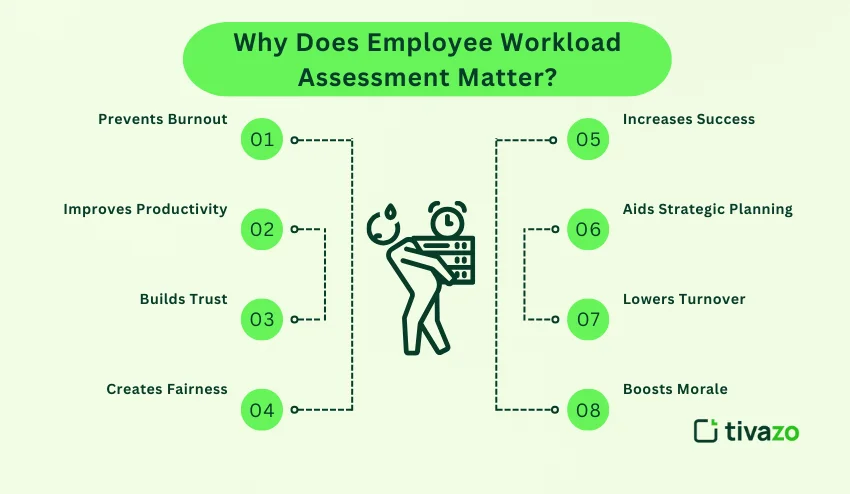
10 Effective Methods for Measuring Employee Workloads
1. Schedule Regular One-on-One Meetings
Regular one-on-one meetings allow employees to share their workloads, challenges, and concerns. These conversations provide insight into how to access workload of employee feel about their workload and will enable you to make necessary changes. In addition, one-on-one meetings help you build trust with your employees, uncover issues that may be undetected, and communicate openly. Over time, this approach will lead to employees feeling supported and connected.
2. Use Task Management Tools
Adopting task management software (e.g., Asana, Trello, or ClickUp) lets managers see how tasks are assigned, due dates approached, and resolutions made in real-time. Task management tools can help managers identify bottlenecks and communicate the distribution of tasks across team members. Additionally, dashboards and reports can help with the identification of access workload of employee who may be over- or under-allocated. By using dashboards and reports, you can manage burdens more speed and accurately.
3. Review Time Tracking Data
Time-tracking tools can reveal where employees can access workload of employee spend their time, placing time against different tasks and categories. By reviewing time-tracking data, managers can identify trends such as consistent long working hours as well as issues that seem to take longer than expected, indicating there may be a work overload problem.
Benefits Of Tracking Time Data:
| Benefit | Description |
| Identify Overload | Detect employees working beyond capacity. |
| Measure Task Efficiency | Determine which tasks consume the most time. |
| Improve Scheduling | Allocate tasks according to employee availability. |
| Support Decision Making | Make data-driven workload adjustments. |
4. Utilize Workload Assessment Frameworks
Frameworks such as the RACI model or the Eisenhower Matrix provide assessments of the urgency and importance of tasks. This serves to clarify to your team, members of the group, and you whether they are focusing on important priorities and overloading them with low-level tasks.
Other Options:
- Consider a scoring system with people rating the complexity and the priority of tasks.
- Identify tasks as urgent, important, or regular to facilitate to access workload of employee assessment.
5. Measure Employee Well-Being
If levels of stress or burnout are high, this may indicate that workloads are not realistic and that adjustments to workloads should be considered to promote overall work environment well-being. A combination of well-being surveys (including task load reviews) and performance metrics may assist managers in identifying direct or indirect correlations between workload and employee satisfaction, keeping in the the importance of access workload of employee.
Well-being bullet points to monitor:
- Assess employee stress and satisfaction quarterly.
- Track absenteeism and turnover as indirect indicators of workload.
- Encourage employees to report workload issues as soon as possible.
Overall, these practices, taken together, will help create a balanced approach to workload management, ensuring tasks can be completed according to capability, organizational priorities, and team workload, in addition to the fact that these practices will help monitor employee well-being.
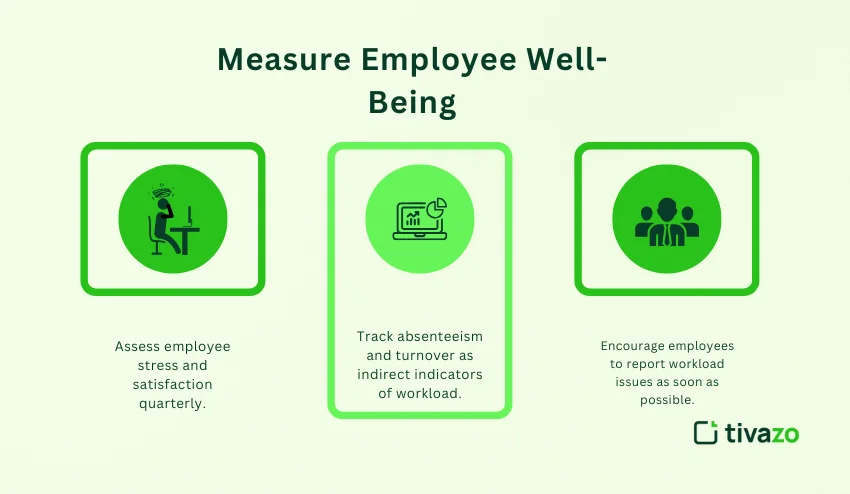
6. Tasks Associated with Employee Skills
Matching an access workload of employee tasks with their skills and capacity is necessary to eliminate the potential for either underutilization of capability or overburdening a team member. By frequently checking to ensure employees’ skills match their respective assignments, a more effective and enjoyable work experience will likely arise for everyone involved. A manager could develop an employee skills matrix to track each employee’s strengths against the tasks required to be performed and make it easier to assign and/or delegate tasks to each team member accordingly.
In this way, the interim results will almost certainly lead to a return on the manager’s productivity, and will, over time, build employees’ confidence and engagement in their work.
Employee Skills Alignment Matrix Example
| Employee | Skills | Allotted Tasks | Areas for Development |
| John | Data Analysis | Reports, Reporting Analytics | SQL Advanced |
| Sarah | Project Management | Team Coordination/Leadership | Leadership Skills |
| Mia | Graphic Design | Marketing Creative Design | UX/UI Basics |
7. Establish Clear Performance Expectations
Providing clear workload expectations assists employees in understanding their priorities and acceptable levels of performance. For example, managers should:
- Explain the order of priority for tasks.
- Be explicit about quality expectations and measures.
- Use dashboard-type tools or charts to show levels of completion.
When access workload of employee have clear expectations that they understand, they are better able to manage workloads, disturbances, and team pressures. They can also develop a greater sense of clarity and control in how they manage their role, which can directly reduce pressures around overload. Clarity and explicit expectations also allow managers to monitor employee performance and provide feedback in an efficient and meaningful way.
8. Create a high level of skill, training, and development
By providing training and development efforts, where access workload of employee can improve their level of skills and therefore take on more complex problems, not overloading their capacity to manage their workloads and make judicious, reasonable recommendations. Upskilling employees leads to:
- Enhancing all employees’ capabilities to prepare for existing or future roles.
- Increased engagement and motivation for teams to perform.
- Future improvements to overall team productivity.
- Good practices for developing employees include regular or intensive workshops, e-learning, and/or mentoring.
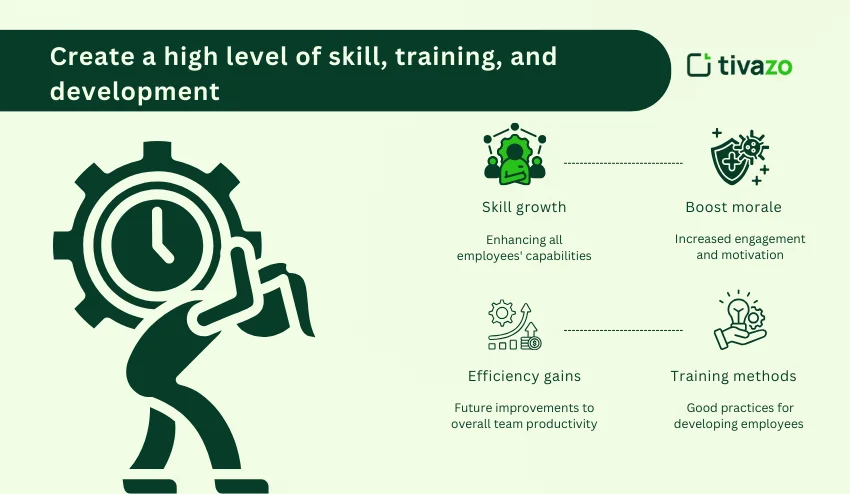
9. Adopt Flexible Work Arrangements
Flexible work arrangements, including remote work, compressed workweeks, or flexible daytime hours, help employees manage their workloads more efficiently. Benefits include:
- Higher job satisfaction.
- Better work-life balance.
- Increased focus and productivity.
Flexibility allows access workload of employee to complete their workload during their most productive hours and to lessen stress caused by less flexible schedules.
10. Reviewing and modifying workload
On a regular basis helps to ensure that the workloads match the organization’s priorities and the state of employee capacity at the same time. Managers would start by:
• Reviewing their employees’ workload monthly or quarterly.
• If there are concerns, redistribute the work based on the current highest priority.
• Rely on performance measures to objectively address issues and document feedback.
| Benefits | Description |
| Avoids Overload | Helps to reduce employee exhaustion by shifting the workload |
| Enhances Performance | Helps to put the workload in alignment with capabilities and availability |
| Supports Engagement | Makes it clear to employees that their workload is valued and within reach |
| Supports Strategic Objectives | Ensures that team workload is aligned with organizational objectives |
Organizations can achieve a balanced, equitable, and productive workplace by utilizing these best practices while developing employee potential and well-being.
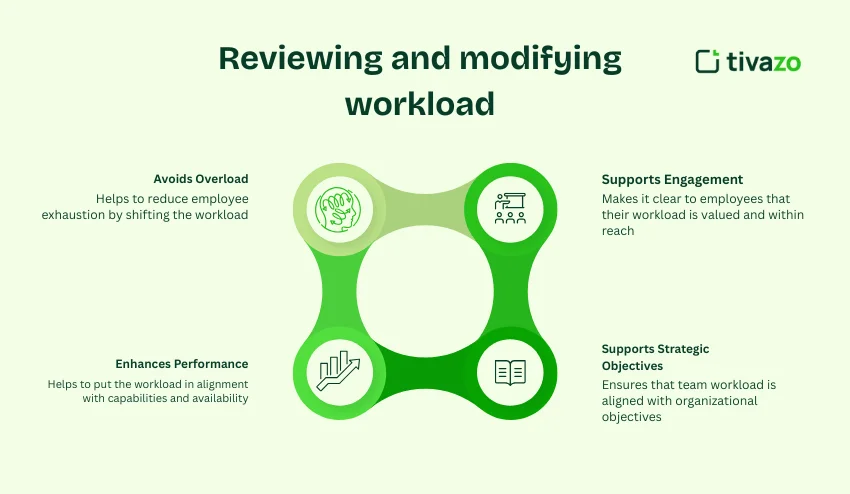
Communicating Workload Expectations with Employees
Engaging in transparent communication about workload expectations is an efficient way to communicate those expectations. Communicating access workload of employee is critical to best evaluate employees’ workloads and to ensure employees are completing their work. Consider the following approaches to assist supervisors with communicating workload expectations:
- Clarify Responsibilities: Clearly define workloads for each individual and the reasons why those workloads are significant to moving the organization’s agenda.
- Clarify Priorities and Deadlines: Be precise about which workloads are prioritized and the deadlines for those workloads that are realistic.
- Utilize Communication Tools: Use dashboards, charts, or project management software to visualize the workload expectations and track workload.
- Schedule Regular Check-ins: Schedule routine one-on-one and team check-ins to communicate any misconceptions, collect feedback, and, if adjustments in workload are required.
- Front Load Communication: Communicate workload expectations in email, work plan guides, and workflow charts, to reinforce that accountability measures are communicated and demonstrated.
- Create Open Communication Channels: Create avenues for employees to voice their concerns about workload, which would allow managers to assess workload of employee and reassign roles evenly.
- Create Measurable Goals: Create goals that are clear and quantifiable to give employees a sense of how to pace their work to hit expectations.
- Review and Adjust: Continually assess progress and adjust as needed to ensure that access workload of employee is balanced and to assist in determining the access workload of employee.
- Support: Provide feedback, training, or other resources if employees are not able to accomplish their tasks.
Putting these tips into practice, managers can promote transparency, fairness, and productivity while effectively assess workload of employee, and maintaining an engaged and motivated workforce.
Conclusion
Evaluating and managing employee workloads is an ongoing process because of the nature of workloads that this involves, attention to detail, communications, and taking advantage of available tools and/or frameworks in the review of employee workloads. Using the approaches outlined in this guide, organizations can access workload of employee workloads and build systems that are fair and balanced, taking into consideration the individualized nature of access workload of employee workloads that align with an employee’s ability to take on more workloads.
Access workload of employee regularly, and as an ongoing process, assist leaders in being proactive in eliminating burnout, increasing productivity, and maintaining high employee satisfaction to improve engagement, motivation, and foster productivity in support of organizational direction and long-term objectives.
